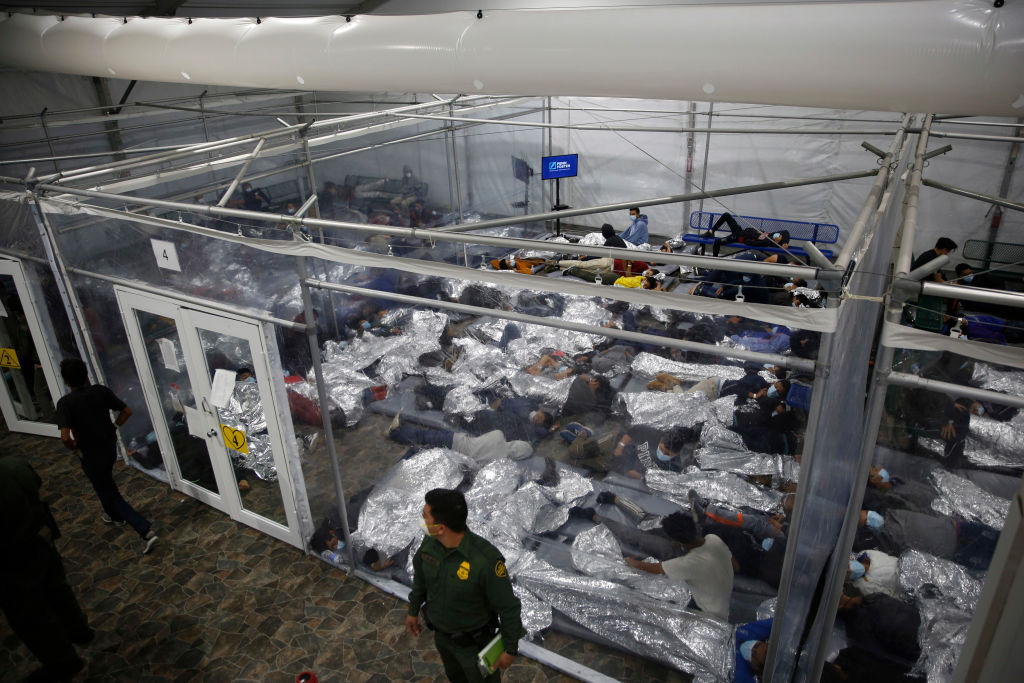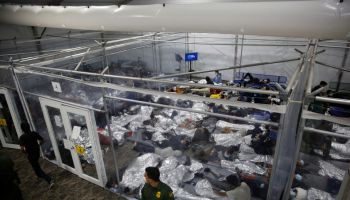
Source: Pool / Getty
For weeks, we’ve heard about a crisis happening at the U.S. southern border and numerous rebuttals from President Biden who has pinned the surge of migrants coming from South America on Republicans as a propagated fear tactic. What started out as the reversal of many Trump-era immigration policies, including freezing construction of the border wall, has morphed into a full-fledged humanitarian disaster.
The children being held captive in cages and detention facilities under the prior administration has grown exponentially over the past two months. A perception over reality scenario with those seeking asylum in the U.S., thinking Biden is more tolerant when it comes to migration efforts, despite the repeated effort of warning people against the trek north.
“The American president said we could come in,” a Guatemalan man expelled by U.S. authorities back to the Mexican border town of Reynosa told The Washington Post’s Kevin Sieff earlier this month. “But they sent us back here.”
That man’s story isn’t unique and is one being told by thousands seeking survival.
Outside the favorable view of the new U.S. president, the influx started almost a year ago in April. People from Central America aren’t coming here for a better life in most cases, but rather, a better set of circumstances. In a part of the world ravaged by the pandemic, a lack of access to health care is one of the many hardships faced due to the economic crises. Add that to the southern states being some of the most accessible places in the world, ending strict Coronavirus lockdowns, prematurely in most cases. All attracting factors for the surge coming across the border.
The Biden administration recognizes that struggle, but contends the real “challenge” goes beyond the border. A $4 billion plan to invest in the Northern Triangle nations was given to Vice President Kamala Harris as a point person, aiming to provide U.S. assistance along with improving quality of life in the region. Her efforts will be to address the “root causes” of Central American migration north. Although, it’s a daunting task for Harris, who’ll play the role of mediator with the diplomatically-challenged nations.
The United States’ long-standing policy of assisting impoverished countries as nothing more than developmental projects will surely get in the way of any total shut down at the border. And the renewed attempt for the Biden administration hasn’t won over many in Central America either.
“Why, after so many decades of systematic support by the U.S. directed at Central America’s structural challenges, has the situation in the region not significantly improved for millions of its peoples?” asked Luis Guillermo Solís, former president of Costa Rica, in an Op-Ed laying out the challenges for U.S. policy-making in the Northern Triangle.
“What factors have impeded and continue to obstruct the aspirations of Central Americans who endure the hardships of lives dominated by fear, dispossession, sickness, corruption and hunger?”
Of course, the United States has played a major role as being the underwriter. But what makes the current situation unlike any the country has seen before is the way asylum seekers are being processed. On average, it takes almost two and a half years to resolve an asylum claim in the U.S., and there’s now a growing backlog of over a million pending cases yet to even hit the initial stage.
As the conditions at the border have worsened, a group of Republican Senators toured the area on the Rio Grande last week to observe the crises. Some of what they witnessed at a detention facility in Donna, Texas was said to be “heartbreaking” and “horrific”, as 4,000+ unaccompanied minors wait to be processed while being “staged” in a cell not fit for living conditions.
Thom Tillis (R-N.C.) was one of the Senators who made the trip south. His observations of the desolate area and its surroundings were described as bleak to WBT’s Pat McCrory Show with Bo Thompson on Wednesday.
“It was horrific. Where we first went, You’ve seen the pictures where they’re processing— just about a half-mile from the Rio Grande River— the flow of illegal immigrants.
And you’ve got babies laying on the ground, basically at midnight, processing them. You go to the Rio Grande and right across the River less than a football field away, you’ve got the human traffickers yelling ‘we’re coming’ and taunting border patrol and the delegation of 18 Senators.
You get on our side and the Biden administration has literally got arrows. About 20 feet from the river’s edge, is an arrow pointing you in the direction, once you cross the river, of how you can go and be processed.
We were told that we couldn’t take cameras. We said noted — and we brought out all our phones— try to do what the press has been unable to do which is report this. We went to the Donna facility— should have about 250-to-300 people in it —got about 4,000
I witnessed and took videos of the COVID testing. They’ve got a courtyard where they had about 100 young men out there sitting in line. They’re testing them fifteen at a time. Then the border patrol goes and marks off the ones who have COVID and they go back in the corner, the others ones get back in the line.
They’re all co-mingled. They’re spreading COVID and other diseases — scabies, lice —the situation is dire.
This is a dangerous public health and safety crisis that President Biden and Vice President Harris owns.” – Sen. Thom Tillis (R-N.C.)
On Wednesday, there were 5,156 children in Border Patrol’s custody and 11,900 children in the Department of Health and Human Services’ custody, according to data released by HHS.
Listen to the entire interview with Senator Thom Tillis on the U.S. border crisis below.










